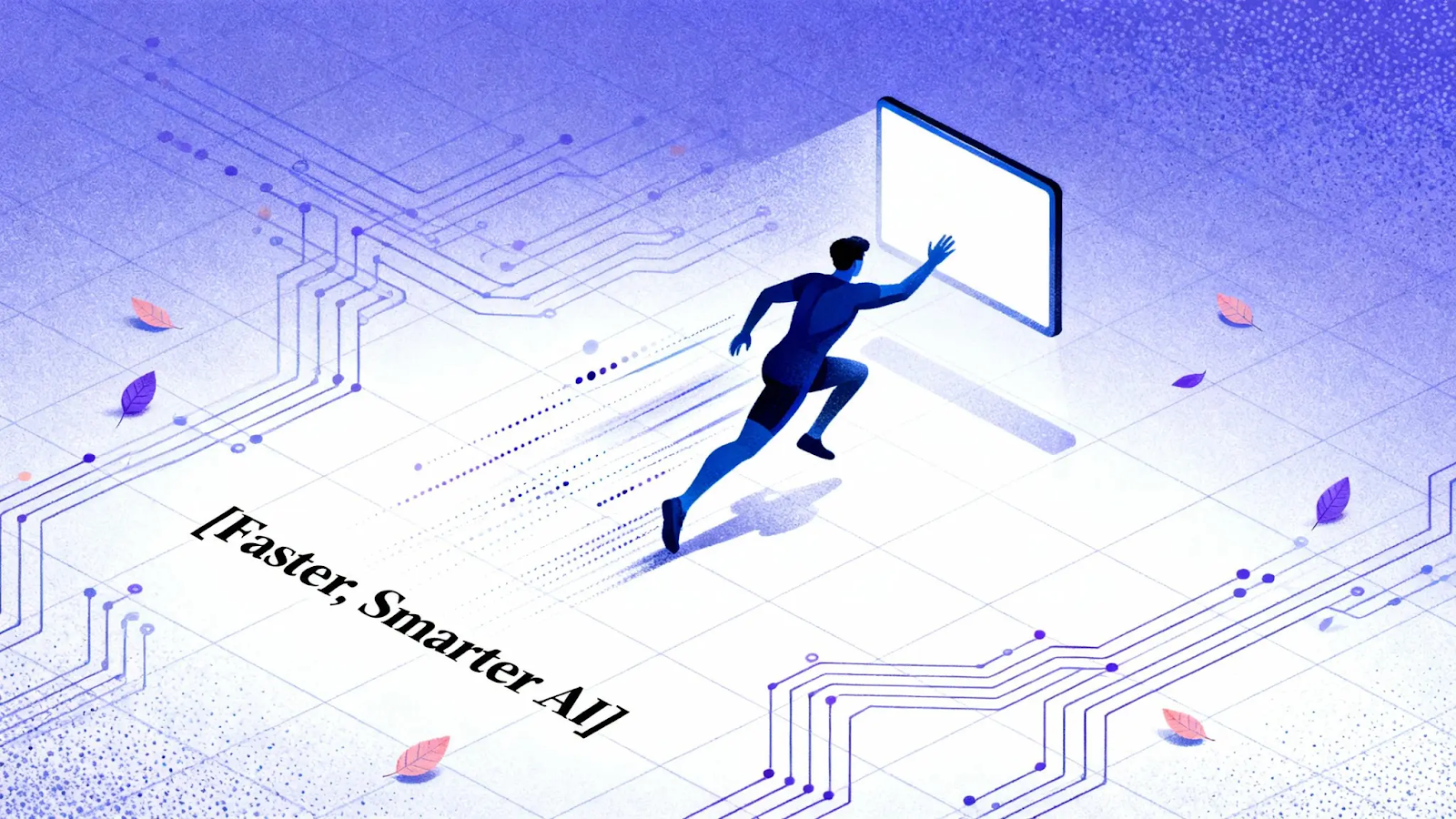10+ Best AI Models Breaking Records in Speed and Smarts
Meet the best AI models shaking up tech. Fast, smart, and unstoppable: see which ones dominate every task. Don’t miss this list!

According to Gartner, global spending on generative AI will reach $644 billion in 2025, nearly double last year’s figure. That kind of growth means one thing for developers and creators: new models, more choices, and more complexity.
With dozens of powerful models launching every quarter, from multimodal LLMs to text-to-video systems, which AI model actually tops the list? Some excel at reasoning, others at creation or automation, and each brings unique trade-offs in speed, cost, and quality.
This guide breaks down the top AI models for 2025, explaining what they do best, where they fit, and how you can start experimenting with them, all in one place.
Quick Snapshot: What You’ll Learn in This Guide
- AI Models Are Now Task-Focused, Not Just Powerful: Each model specializes in something different. Some lead in reasoning and automation, while others excel in creativity and visual generation.
- Multimodal Capabilities Define the New Benchmark: Leading models like GPT-5 and Gemini Ultra handle text, visuals, and audio together, making complex creative and analytical tasks smoother.
- Open Source Models Are Matching Proprietary Giants: Platforms like Llama 4 and Mistral Large prove that community-driven innovation can rival commercial tools in performance and scalability.
- Trust, Safety, and Transparency Are Core to Enterprise AI: Claude 4 and Cohere Command-R Plus focus on explainable outputs, bias control, and data privacy, helping businesses adopt AI responsibly.
- Blended Model Workflows Deliver the Strongest Results: The most efficient systems use multiple AI models together, combining text, image, and video generation for faster, higher-quality outcomes.
What Are The Different Types of AI Models?
At their core, AI models are computer systems trained to recognize patterns in data and utilize those patterns to perform specific tasks, such as generating text, creating images, writing code, or even producing short videos.
Each model learns differently based on what it’s trained on:
- Language models (like GPT or Claude) learn from text, so they can write, summarize, or answer questions.
- Vision models (like DALL·E or Runway Gen-3) learn from images and videos, so they can generate visuals or understand scenes.
- Multimodal models (like Gemini or GPT-4o) combine both: handling text, images, audio, and video in a single workflow.
In simple terms, an AI model is like a specialized tool in a creative or development toolkit. Some are general-purpose and can handle a variety of inputs, while others are optimized for speed, cost, or niche domains like science, finance, or media.
10+ The Top AI Models in 2025: What Makes Them Stand Out?
From reasoning and coding to creating lifelike videos, the latest generation of models is faster, more efficient, and capable of working across multiple data types. Whether you’re a developer, designer, or AI enthusiast, knowing which models are leading the way helps you choose the right tools for your next project. Below, we’ve listed the top AI models shaping 2025:
1. GPT-5 (OpenAI)
Overview:
The newest iteration in the GPT series, GPT-5 builds on GPT-4’s reasoning power and multimodal flexibility. It’s designed for deeper contextual understanding and better accuracy across long, complex tasks.
Why it stands out:
- Handles text, images, and data inputs in a single context.
- More accurate reasoning and fewer hallucinations.
- Ideal for automation agents, chatbots, and enterprise workflows.
Use it for:
Text generation, summarization, data analysis, or powering intelligent digital assistants.
2. Gemini Ultra (Google DeepMind)
Overview:
Gemini Ultra pushes multimodality further by combining text, image, video, and audio reasoning. It’s deeply integrated with Google’s ecosystem and excels in real-time analysis.
Why it stands out:
- Multimodal understanding across all formats.
- Excellent for cross-media research and creative generation.
- Integrates with existing Google AI tools.
Use it for:
Multimedia content creation, video analysis, and creative storytelling powered by real-time data.
3. Claude 4 (Anthropic)
Overview:
Claude 4 emphasizes safe, transparent, and explainable AI. It features long-context memory and reliable reasoning, making it ideal for compliance-driven environments.
Why it stands out:
- Built with ethical and bias-aware frameworks.
- Handles context windows of up to 200k+ tokens.
- Strong in enterprise applications requiring auditability.
Use it for:
Policy generation, research assistance, and enterprise chatbots.
4. Llama 4 (Meta)
Overview:
Meta’s Llama 4 is the leading open-source LLM for 2025, offering exceptional scalability and fine-tuning capabilities.
Why it stands out:
- Fully open-source and customizable.
- Efficient mixture-of-experts architecture.
- Large context windows for research and production.
Use it for:
Research, domain-specific assistants, and applications needing local deployment.
5. DeepSeek V3
Overview:
DeepSeek specializes in mathematical reasoning and structured logic. It’s widely used in finance, forecasting, and data-driven industries.
Why it stands out:
- Exceptional numerical accuracy.
- Designed for logic-heavy and financial reasoning tasks.
- Competitive speed and cost profile.
Use it for:
AI-driven analysis, financial modeling, and decision-support systems.
6. Grok 4 (xAI)
Overview:
Developed by Elon Musk’s xAI, Grok 4 combines strong reasoning with real-time data and web access.
Why it stands out:
- Multimodal with live tool integration.
- Handles text, image, and voice inputs.
- Ideal for real-time agents and enterprise automations.
Use it for:
Search-enabled chatbots, real-time research tools, and intelligent assistants.
7. Cohere Command-R Plus
Overview:
Cohere’s enterprise model is built for scalability and retrieval-augmented tasks. It’s a favorite among teams building secure, private LLM applications.
Why it stands out:
- Optimized for RAG and search workflows.
- Enterprise-grade privacy and compliance.
- Strong multilingual capabilities.
Use it for:
Search tools, document intelligence, and enterprise assistants.
8. Mistral Large
Overview:
Mistral continues to lead open-source innovation. Mistral Large offers excellent performance and efficiency, rivaling proprietary models at lower cost.
Why it stands out:
- Fully open-source and fast inference.
- Easy customization for domain data.
- Cost-efficient for large deployments.
Use it for:
Translation, automation, and custom enterprise chat solutions.
9. Runway Gen-3 Alpha Turbo
Overview:
Runway’s latest video model is redefining AI-generated motion. It transforms text or image prompts into realistic cinematic clips within seconds.
Why it stands out:
- Superior motion realism and frame stability.
- Supports both text-to-video and image-to-video.
- Outputs up to 10-second clips with smooth transitions.
Use it for:
Film pre-visualization, marketing videos, and generative VFX.
10. AlphaFold 3 (DeepMind)
Overview:
AlphaFold 3 continues to lead in molecular modeling and biology, predicting protein and biomolecular structures with remarkable accuracy.
Why it stands out:
- Unmatched biological prediction capabilities.
- Accelerates drug discovery and synthetic biology.
- Expands molecular interaction understanding.
Use it for:
Life sciences research and biotech development.
11. GitHub Copilot X
Overview:
The latest generation of GitHub Copilot is powered by OpenAI models and designed for deeper code understanding and context-aware assistance.
Why it stands out:
- Enhanced code generation and debugging.
- Integrated with IDEs for real-time assistance.
- Ideal for teams adopting AI pair programming.
Use it for:
Code generation, refactoring, and documentation automation.
12. BLOOM Z
Overview:
BLOOM Z is a multilingual, open-source model designed for inclusivity and academic research. It handles over 40 languages and multiple programming syntaxes.
Why it stands out:
- Open-access and transparent.
- Ideal for research and global NLP.
- Community-driven updates and fine-tuning.
Use it for:
Translation, cross-language applications, and educational projects.
Which AI Model Should Businesses Use in 2025?
No single AI model can do it all. Some excel at reasoning and writing, others at creating visuals or generating video. The best results often come from using more than one — combining models that complement each other.
That’s where Segmind makes a real difference. Instead of switching between tools, you can try, compare, and run multiple AI models in one place. Want to generate visuals, upscale them, and then turn them into videos? You can do it all within the same workflow.
For most teams, 2025 won’t be about finding “the best model.” It’ll be about using the right mix of models efficiently, and Segmind makes that part easy.
Conclusion
AI in 2025 is more capable, connected, and creative than ever. The biggest shift isn’t just in what these models can do, it’s in how easily you can use them together. From text generation to image creation and full video workflows, the real power lies in combining models that complement each other.
That’s where Segmind fits in. It gives you a single platform to explore, test, and connect the best AI models, all without managing hardware or complex setups. Whether you’re building creative projects, automating workflows, or experimenting with new generative tools, Segmind helps you move faster and stay ahead of what’s next in AI. Try it today
FAQs
Q: How can professionals integrate this tool into their creative workflows without disrupting existing pipelines?
A: Start by assigning small, low-risk creative tasks to the tool to test compatibility. Gradually expand usage after confirming consistent output quality. Integrate it into feedback loops for efficiency gains.
Q: What are the best practices for maintaining consistency when generating multiple visuals with similar themes?
A: Use structured prompts with controlled parameters to guide visual uniformity. Save preferred settings as templates to maintain continuity across projects. Regularly compare outputs for alignment.
Q: How can this model assist teams working across design, marketing, and product development simultaneously?
A: It accelerates cross-functional collaboration by generating shared visual references. Teams can refine visuals collectively, saving time on revisions and misunderstandings. It simplifies creative communication.
Q: Can businesses use this tool to speed up iteration cycles for campaign visuals?
A: Yes, it shortens concept-to-final cycles by generating multiple creative options instantly. Marketing teams can quickly test, adapt, and finalize visuals aligned with campaign goals.
Q: What parameters influence visual accuracy the most when generating complex compositions?
A: Prompt clarity, reference image selection, and seed control strongly impact output precision. Consistent parameter tuning ensures repeatable, production-grade visuals for complex design needs.
Q: How can artists balance AI-generated creativity with their own artistic direction?
A: Treat AI outputs as concept drafts rather than final artworks. Use them to explore composition, lighting, or perspective before applying your personal creative interpretation.

